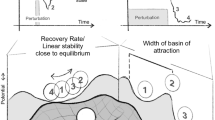Abstract
The interdependencies among land use systems at national and global levels motivate the development of advanced systems analysis approaches for integration of land use models operating at different weights. The paper develops novel general approaches based on cross entropy principle for downscaling aggregate data and projections, which are robust with respect to feasible priors. Robust downscaling methods account for so-called non-Bayesian uncertainties, i.e., incomplete, unobservable, or erroneous information or data. In numerous case studies in China, African countries, Brazil, and Ukraine, the approaches allowed deriving local development projections of land use and land use change consistently with existing trends and expectations.
Similar content being viewed by others
References
E. F. Lambin and P. Meyfroidt, “Global land use change, economic globalization, and the looming land scarcity,” Proc. Natl. Acad. Sci. USA, Vol. 108, No. 9, 3465–3472 (2011).
C. Agarwal, G.M. Green, J.M. Grove, T.P. Evans, and C.M. Schweik, “A review and assessment of land-use change models: Dynamics of space, time, and human choice,” Gen. Tech. Rep. NE-297, Newton Square, PA, U.S. Department of Agriculture, Forest Service, Northeastern Research Station (2002).
K. M. Chomitz and D. A. Gray, “Roads, land use, and deforestation: A spatial model applied to Belize,” World Bank Econ. Rev., Vol. 10, 487–512 (1996).
H. Lotze-Campen, A. Popp, T. Beringer, C. Müller, A. Bondeau, S. Rost, and W. Lucht, “Scenarios of global bioenergy production: The trade-offs between agricultural expansion, intensification and trade,” Ecological Modeling, Vol. 221, 2188–2196 (2010).
C. E. Shannon, “A mathematical theory of communication,” Bell System Technical Journal, Vol. 27, 379–423, 623–659 (1948).
J. Kullback, Information Theory and Statistics, John Wiley and Sons, New York (1959).
A. G. Zagorodny, Y. M. Ermoliev, and V. L. Bogdanov, “Integrated management, security and robustness,” Publ. by Committee for Systems Analysis and Presidium of National Academy of Sciences, Ukraine, National Member Organization of the International Institute for Applied Systems Analysis (IIASA), ISBN 978-966-02-7376-4, Kyiv (2014).
P. Havlík, U. Schneider, E. Schmid, H. Böttcher, S. Fritz, R. Skalsky, K. Aoki, S. De Cara, G. Kindermann, F. Kraxner, S. Leduc, I. McCallum, A. Mosnier, T. Sauer, and M. Obersteiner, “Global land-use implications of first and second generation biofuel targets,” Energy Policy, Vol. 39, 5690–5702 (2011).
R. C. Izaurralde, J. R. Williams, W. B. McGill, N. J. Rosenberg, and M. C. Q. Jakas, “Simulating soil C dynamics with EPIC: Model description and testing against long-term data,” Ecological Modeling, Vol. 192, 362–384 (2006).
G. Fischer, H. T. van Velthuizen, M. M. Shah, and F. O. Nachtergaele, “Global agro-ecological assessment for agriculture in the 21st century: Methodology and results,” Research Report RR-02-02, International Institute for Applied Systems Analysis, Laxenburg, Austria (2002).
L. M. Bregman, “Proof of the convergence of Sheleikhovskii’s method for a problem with transportation constraints,” USSR Computational Mathematics and Mathematical Physics, Vol. 7, No. 1, 191–204 (1967).
G. Fischer, W. Winiwarter, T. Ermolieva, G.-Y. Cao, H. Qui, Z. Klimont, D. Wiberg, and F. Wagner, “Integrated modeling framework for assessment and mitigation of nitrogen pollution from agriculture: Concept and case study for China,” Agriculture, Ecosystems & Environment, Vol. 136, No. 1, 116–124 (2010).
Author information
Authors and Affiliations
Corresponding author
Additional information
*The studies are carried out within the framework of the EU-projects ECONADAPT (603906), TRANSMANGO (613532), AGRICISTRADE (612755) EU FP7, and the scientific project on the development of innovative methodologies and applications that investigate robust decisions for long-term coordinated planning of safe provisioning, energy and water supply, performed jointly by the International Institute for Applied Systems Analysis (Laksenburg, Austria) and National Academy of Sciences of Ukraine..
Translated from Kibernetika i Sistemnyi Analiz, No. 1, January–February, 2017, pp. 31–41.
Rights and permissions
About this article
Cite this article
Ermoliev, Y.M., Ermolieva, T.Y., Havlík, P. et al. Robust Downscaling Approaches to Disaggregation of Data and Projections Under Uncertainties: Case of Land Cover and Land Use Change Systems* . Cybern Syst Anal 53, 26–33 (2017). https://doi.org/10.1007/s10559-017-9904-z
Received:
Published:
Issue Date:
DOI: https://doi.org/10.1007/s10559-017-9904-z




